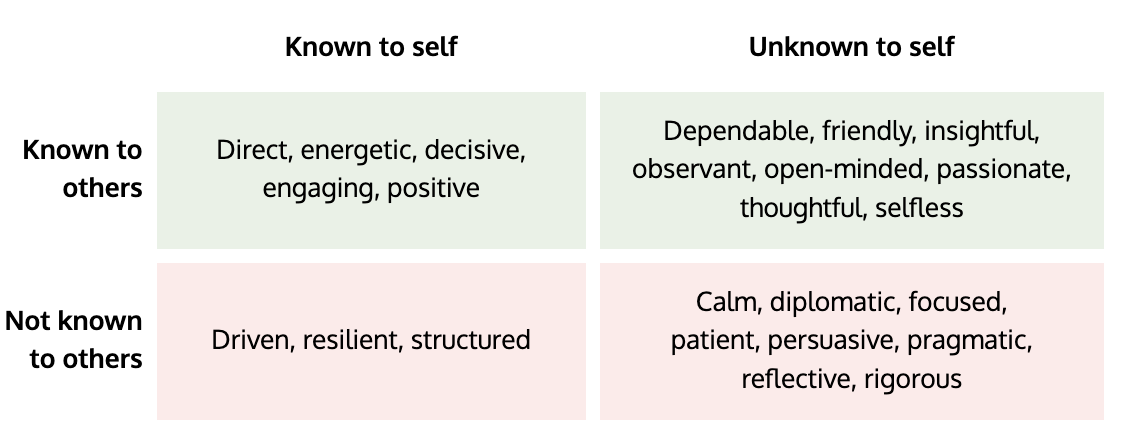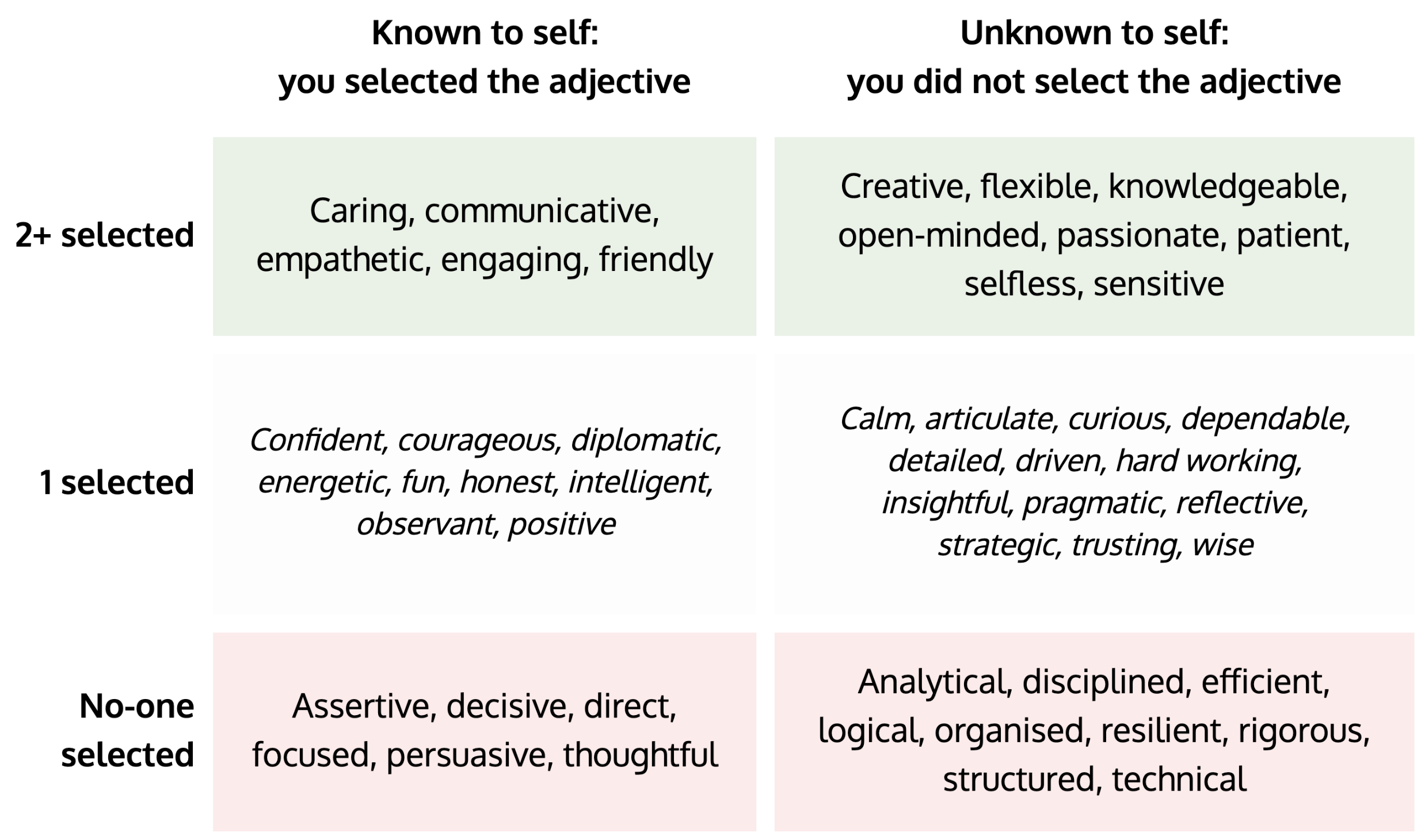One of the defining traits of a Product Manager is curiosity. We usually think of this curiosity as something that extends outwards: you use curiosity to understand the market, the customers, the business model, and technology.
But what about yourself? The truth is, we rarely think of a Product Manager’s curiosity as something that should be cast inwards. Do you have a clear sight of your weaknesses? Do you know how others perceive you? Do you understand how you show up in conflict? In a job full of communication and interpersonal exchange, self-awareness is a priceless skill to have.
Introducing the Johari Window
To help my clients to improve their self-awareness, I often use a tool called the Johari Window.
In 1955, psychologists Joseph Luft and Harrington Ingham combined their names and expertise to create this exercise. It reveals the differences between how others view you, and how you view yourself.
To begin the exercise, you receive a list of personality traits (more on this later). From the list, you choose the traits you feel describe you best. The same list is then given to others that know you, such as your close colleagues and teammates, and they choose the traits that they think describe you best. The results are presented in a 2x2 grid (the window) which looks like this:
An example of a finished Johari Window.
Your window tells a story of how the world sees you, how you see yourself, and how well those perspectives do, or don't, align.
Luft and Ingham gave each area of the Johari Window a name:
The Arena (top left) is where your inner and outer perceptions are fully aligned. Here, your self-perception matches how others see you.
The Façade (bottom left) holds the traits that you see in yourself, but for some reason others do not. The Façade raises the question: are these traits hidden from view, or not really there at all?
The Blind Spot (top right) is often the most intriguing. These are traits that others see in you, but you don’t see in yourself. Taken together with The Façade, we have two contesting narratives for who you are in the world.
The Unknown (bottom right) shows the remaining traits, selected by neither you nor others.
Is that how people really see me?
Testing this method out proved to be a bigger struggle than I expected. I assumed that people would be eager to try it out. After all, the Johari Window is relatively harmless: it only considers positive traits. In the worst case scenario, you’ll be praised in a different way than you expected!
I assumed wrong. When suggesting this method to clients, I met great resistance. People would squirm at the idea. They feigned interest but didn't commit, or manufactured excuses for not completing the exercise. (“The dog ate my Johari Window”, etc. etc.)
A great friend of mine has always insisted that her deepest fear is that everyone secretly considers her to be an idiot. She is brilliant, thoughtful and highly intelligent. Yet, somehow, she’s afraid that she’s the one person who doesn’t see her true identity. In the end we are all social creatures, wearing our identities like armour. It makes us feel strong to know who we are, what we’re valued for, and where we belong. To think that we might misjudge that – that our identity could be different than we realise – is an uncomfortable thought. So much so, that many people would rather not ask the question at all.
If you’re intrigued but still hesitant to try the Johari Window, perhaps your fear is serving your ego more than it is serving you. The question is, in a battle between your fear and your curiosity, which one would you like to win?
When one of my clients is theoretically convinced of the Johari Window but somehow hesitating to take the plunge, it’s always interesting to dig into why. What negative consequences are they imagining playing out? What is it about these worst-case scenarios that is so potent to them?
To reframe the exercise for a client, I might challenge them to a bet: try the Johari Window, and should they regret it afterwards, I will buy them a drink in compensation. I’m yet to lose this bet; credit for this tactic goes to Matt Mochary, who is also yet to lose. For more on confronting your fears, I highly recommend reading Matt’s text ‘Fear and Anger give bad advice’, which concludes with the suggestion of creating a fear journal, a similar technique from Regina Gerbeaux:
If there is no one that you feel comfortable making a bet with, then make a bet with yourself… Whenever you feel fear, or someone tells you that they perceive you to be in fear, write down what prediction your brain is making. Do this regularly so that you are able to make many predictions. Then, a week or a month or a year later, go back and read the predictions that you made. See how many of them actually came true. And if any came true, ask yourself if that outcome was actually negative.
A free Johari Window template to get started
Since I started using the Johari Window, I’ve been iterating on an initial list of 50 personality traits. I’ve chosen traits from everyday language that feel most relevant to working as a Product Manager or Leader. Here’s the current list:
Analytical, articulate, assertive, calm, caring, communicative, confident, courageous, creative, curious, decisive, dependable, detailed, diplomatic, direct, disciplined, driven, efficient, empathetic, energetic, engaging, flexible, focused, friendly, fun, hard working, honest, insightful, intelligent, knowledgeable, logical, observant, open-minded, organised, passionate, patient, persuasive, positive, pragmatic, reflective, resilient, rigorous, selfless, sensitive, strategic, structured, technical, thoughtful, trusting, and wise.
I’ve created a template Google form to get you started. You can use the form to collect answers anonymously. It displays the 50 traits in random order to reduce bias. Here it is: https://docs.google.com/forms/d/1ZiZ9IczUUsgxE70xcP9kJlw7dOHEYN25kY43OY5scW0/template/preview
Making your own Johari Window is simple. Just follow these 3 steps:
CHOOSE YOUR TRAITS
Identify the traits (5 or more) that you think best describe you from the list.ASK OTHERS
Create your own form with the template. Ask a handful of your closest colleagues if they could fill it in, to help with your personal development. To maintain anonymity, I recommend sharing with them all at once, with a clear due date for responses (no peeking until then!)
If you feel a little sheepish directly asking colleagues like this, there are alternatives. You could ask a colleague, such as your line manager, team lead, or your coach, to collect answers on your behalf. Or you could include the survey in your 360 performance review, as part of the feedback process.ASSEMBLE YOUR WINDOW
You now have all the pieces. Time to put it all together! Use your tool of choice: whiteboarding tools (Miro, Mural) and text editors with tables (Notion, Google Docs or even Excel) both work well. The Johari Window is traditionally a 2x2 grid. However, based on testing, I prefer a 2x3 grid (see below). The middle layer displays traits that were selected by only 1 colleague. In this way, you can separate out the traits with a stronger consensus.
An example of a Johari Window with a 2x3 grid. What conclusions might you draw about this person?
Once you have your window, take time to reflect on what you see:
How much alignment is there between you and others? What kind of traits is there agreement over?
Consider The Blind Spot (top right). What do these traits tell you about how people perceive you? What might be stopping you from recognising these traits in yourself?
Consider The Façade (bottom left). What might be stopping others from seeing these traits? Does it matter if they don’t? What might need to change, for others to recognise these traits?
Considering the window as a whole, what does it tell you about yourself and your context?
That’s it. Simple, right?
If you try it, I would love to hear from you. How did it make you feel, and what did you learn? Did you find any interesting ways to vary the exercise?
– Shaun










